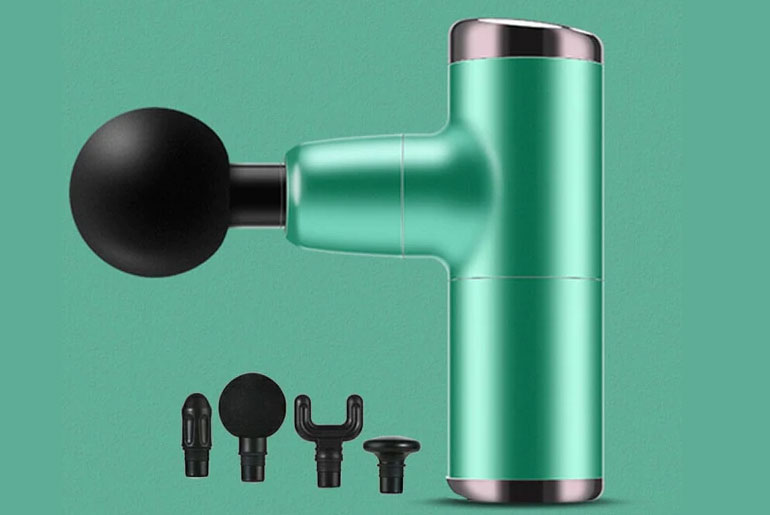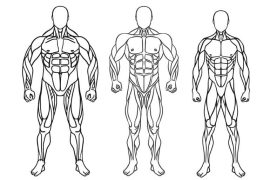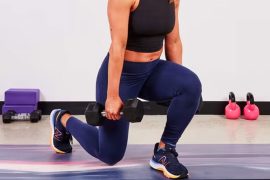Benefits of Massage Guns and Why They’re a Game-Changer for Wellness:
A massage gun, also known as percussive massage treatment or vibration therapy device, is a portable and handheld tool resembling a power drill. Typically wireless with a rechargeable battery, massage guns come with interchangeable attachments. When applied to muscles and activated, these attachments vibrate or “percuss” at a high frequency and low amplitude of movement. Advocates claim that this percussive massage treatment promotes recovery from workouts, enhances overall performance, and reduces muscle soreness.
While there is limited conclusive evidence directly linking massage guns to training benefits, the underlying principles of percussive massage treatment draw from established therapeutic methods. Massage, involving the kneading and manipulation of muscles, has been shown to reduce tension, improve flexibility, increase blood flow, and decrease muscle soreness. Similarly, vibration therapy, where vibrating devices are applied to specific body parts, has demonstrated effects comparable to massage therapy in limiting delayed onset muscle soreness (DOMS) — the tightness and achiness felt a day or two after intense physical activity.
While massage guns can be used to relieve muscle tension at any time, they are often recommended for post-workout recovery to help reduce muscle soreness. It’s important to note that individual responses to massage guns may vary, and it’s advisable to use them cautiously, especially for those with certain health conditions or injuries. Additionally, incorporating massage guns into a comprehensive recovery strategy, along with proper nutrition, hydration, and rest, can contribute to overall well-being and athletic performance.
Differences Between Massage Guns, Foam Rollers, and Other Muscle Recovery Options:
-
Massage Guns:
Massage guns provide a rapid, percussive form of massage, aiming to reduce muscle tension, enhance blood flow, and promote recovery. While they offer similar effects as foam rolling and massage, their approach is different due to the quick, pulsating nature of the percussion. Massage guns are portable and often allow for targeted application to specific muscle groups.
-
Foam Rollers:
Foam rolling utilizes myofascial release, targeting the fascia, which is the connective tissue surrounding muscles, blood vessels, and nerves. By applying gentle to moderate sustained pressure with a foam roller, tight or inflamed areas of fascia can relax or release. Foam rolling is a form of self-massage that helps decrease muscle tension and improve mobility.
-
Static Stretching:
Static stretching involves slow, sustained stretches on a muscle to promote relaxation and reduce feelings of muscle tightness. Unlike massage guns and foam rolling, static stretching doesn’t involve external tools but relies on the individual’s movements to elongate muscles and increase flexibility. It has a more gradual and passive approach to muscle relaxation.
The choice between these muscle recovery options may depend on personal preferences, goals, and the specific needs of an individual. Some people may prefer the convenience and targeted application of a massage gun, while others may opt for the self-directed myofascial release provided by foam rolling or the gradual stretch and relaxation achieved through static stretching. Combining these methods based on individual preferences and incorporating them into a comprehensive recovery routine can contribute to overall muscle health and flexibility.
How to Effectively Use a Massage Gun for Maximum Muscle Recovery:
Using a massage gun effectively involves a thoughtful approach to target muscle tension and promote relaxation. Here’s a step-by-step guide on how to use a massage gun:
- Choose the Right Time: Massage guns can be used whenever you want to relieve muscle tension, but they are commonly used both before workouts to activate muscles and after workouts to reduce soreness or stiffness. They are most effective within 48 hours following a workout.
- Identify Tight Areas: Locate areas on your body that feel tight or are prone to soreness.
- Apply the Gun: Start by moving the massage gun over the bulk of the muscle in the identified area. Begin with gentle pressure and gradually increase it as tolerated. Many massage guns have a button or switch to adjust the pressure.
- Duration and Technique: Stay in one spot for up to 15 seconds, applying sustained pressure, or sweep the gun across an area for about 2 minutes. Some massage guns come with monitors connected to apps that guide the intensity and duration in different areas.
- Avoid Bony Areas and Injuries: Stay away from bony areas, and if you have an existing injury, consult with a physical therapist before using a massage gun on it. Avoid going over areas of acute pain or injury, as it may worsen the condition.
- Moderate Pressure: It’s essential to apply pressure judiciously. If you feel more sore after using a massage gun, you may have pushed too hard or too long. The goal is to relax and feel better, not to cause discomfort.
- Consider Individual Health Factors: If you have nerve sensitivity, deep vein thrombosis, or if you are pregnant, consult with your doctor before using a massage gun. Individuals who bruise easily should ensure that the speed and attachment are suitable for their tolerance.
Remember that using a massage gun is part of an overall recovery strategy, and it should be complemented by other healthy habits, such as proper nutrition, hydration, and adequate rest. If in doubt or if you experience persistent discomfort, it’s always a good idea to consult with a healthcare or fitness professional.
A Buyer’s Guide to Selecting the Perfect Massage Gun:
When deciding to buy a massage gun, it’s essential to carefully evaluate your purchase, considering factors like size, features, and functionality. Here are some key considerations to keep in mind:
- Reviews: Start by researching and reading online reviews to understand the experiences of other users with specific massage guns. This can provide valuable insights into the effectiveness, durability, and overall satisfaction with the product.
- Size and Comfort: Consider the size and weight of the massage gun. Think about your own comfort level regarding how heavy and large you want it to be, and which muscles you plan to target. Some massage guns come with adjustable heads and handles, making it easier to reach different body parts.
- Portability: If you plan to take the massage gun on the go, consider portability. Mini massage guns might be a suitable option, as they are more compact and can easily fit into a backpack.
- Attachments: Check that the massage gun comes with different attachments to target various muscle groups and reach challenging spots. Different attachments provide versatility and adaptability for different areas of the body.
- Settings and Intensity: Look for a massage gun with multiple intensity settings, allowing you to choose between more gentle or more intense percussive movements. This versatility is crucial as different muscle groups may require varied levels of pressure.
- Noise Level: Pay attention to the noise level of the massage gun. Some models operate more quietly than others, and this can impact your overall experience, especially if you plan to use it in shared spaces or want a more relaxing session.
- Brand Reputation: Consider the reputation of the brand. Well-established and reputable brands often provide better quality and customer support. Look for brands with positive reviews and a track record of delivering reliable products.
- Battery Life: Check the battery life of the massage gun, especially if you plan to use it frequently. Longer battery life ensures that the device remains operational for extended periods without requiring frequent recharging.
- Warranty: Investigate the warranty and customer support offered by the manufacturer. A reliable warranty can provide peace of mind in case of any malfunctions or issues with the product.
- Price: While top-of-the-line massage guns can be expensive, it’s essential to find a balance between your budget and the features you need. Consider your specific requirements and how well the massage gun aligns with them.
By carefully considering these factors, you can make an informed decision and choose a massage gun that meets your individual needs and preferences.
Disclaimer:
The information contained in this article is for educational and informational purposes only and is not intended as a health advice. We would ask you to consult a qualified professional or medical expert to gain additional knowledge before you choose to consume any product or perform any exercise.








